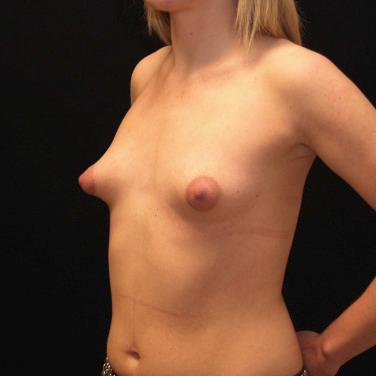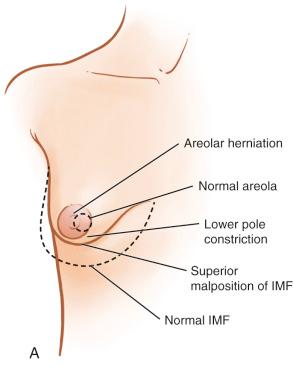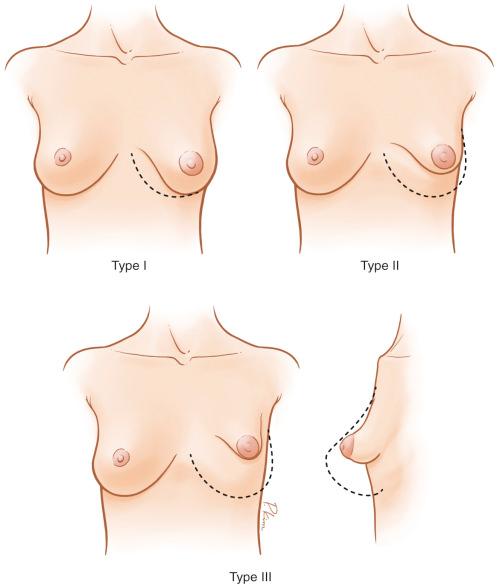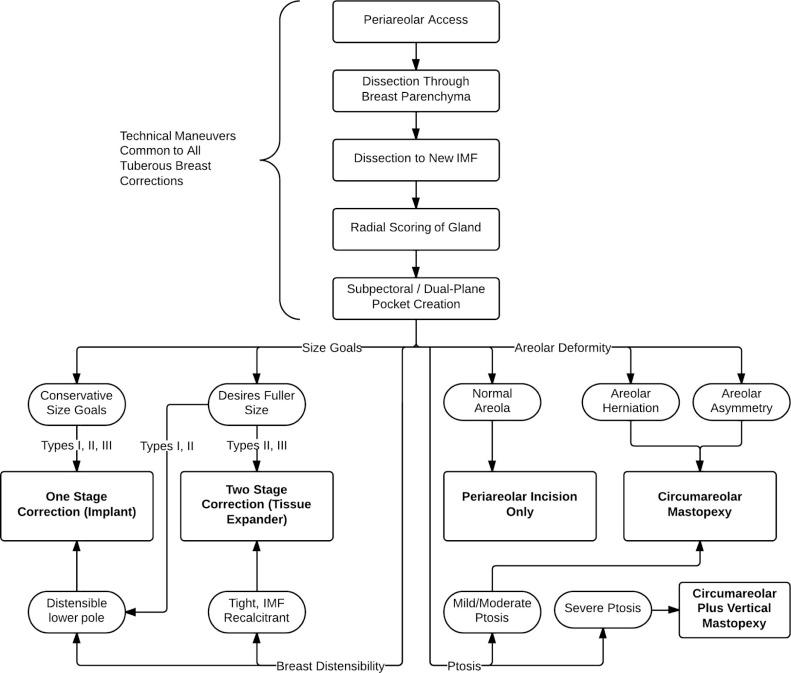Physical Address
304 North Cardinal St.
Dorchester Center, MA 02124
Tuberous breast deformity is a congenital anomaly with widely variable morphologic presentation. The etiology remains uncertain, although it is postulated that the deformity has an embryologic origin with a possible genetic predisposition; however no clear link has yet been determined. The physical manifestations of tuberous breasts have been attributed to periareolar fibrous ring constriction and hypoplastic, elastic areolar fascial support, the combination of which predisposes to narrow ventral-vector development of the breast bud into a more pliable and less resilient areola, resulting in a peripherally constricted appearance of portions of the breast with herniation of the areolar complex ( Fig. 24.1 ). The most frequently observed characteristics of tuberous breast deformity include breast base constriction, parenchymal hypoplasia, lower pole skin deficiency, superior malposition of the inframammary fold (IMF), areolar herniation, and ptosis, as demonstrated in Fig. 24.2 . The physical manifestations can vary widely in severity, with one, several, or all of these features present ( Fig. 24.3 ). Asymmetry is also a frequent hallmark of tuberous breast deformity, with discrepancies seen in breast size, shape, areolar dimension and herniation, and degree of ptosis.



Tuberous breast deformity can present exceptional challenges for surgeons as much from the subtle cases as the severe. The technical demands of enhancing or creating a lower breast pole, controlling areolar herniation, correcting ptosis, and improving symmetry of breast size, shape and areolar dimensions are frequently substantial. Tuberous breasts are often underappreciated and underdiagnosed, with patients often expecting, and surgeons regrettably performing, a standard breast augmentation.
Identification and classification of the presence and severity of each feature of the deformity, or combination thereof, is critical in the establishment of a treatment plan. Von Heimburg, Grolleau, Meara, and Costagliola have proposed classification systems to define the spectrum of tuberous breast deformity. We prefer employing a three-tiered classification that incorporates the specific pathologic hallmarks of the deformity ( Fig. 24.4 ), and that facilitates the formulation of a treatment strategy that can be tailored on an individual basis to all patients based on morphology and deformity severity ( Table 24.1 ).

| Type | Base | Inframammary Fold | Skin Envelope | Breast Volume | Ptosis | Areola |
|---|---|---|---|---|---|---|
| I | Minor constriction | Normal laterally, minor elevation medially | Sufficient | Minimal deficiency, no deficiency, or hypertrophy | Mild, moderate, or severe | Enlargement |
| II | Moderate constriction | Medial and lateral elevation | Inferior insufficiency | Moderate deficiency | None or mild | Normal, mild or moderate herniation |
| III | Severe constriction | Elevation of entire fold, or fold absence | Global insufficiency | Severe deficiency | Mild/moderate | Severe herniation |
The keys to success in tuberous breast correction include the interruption of the fibrous ring constriction, release and expansion (in one or more stages) of lower pole deficiency, establishment of an appropriately positioned IMF, overcoming pre-existing IMF memory, augmenting the deficient lower pole for both volume and shape maintenance, reduction of areolar herniation, balancing areolar dimensions, correcting ptosis, and correcting asymmetry.
Women with any degree of tuberous breast deformity may be candidates for surgical correction, as the effects of the developmental anomaly are most often psychological, related to the self-perception of having “abnormally shaped” breasts. Ideal candidates are women with tuberous breast deformity who have completed breast development, and optimally have been at a plateau of stable breast shape and size for one year. Around 18–19 years is a common age for initial consultation and treatment. Consideration may occasionally be given to younger girls (15–17 years) with marked asymmetry, deformity or extreme emotional distress, with the caveat that continued breast development may increase the likelihood of a secondary surgery. In such cases, particularly in those with unilateral severe hypoplasia, the use of tissue expanders or adjustable implants may be beneficial to remain apace with potential progressive breast growth. Surgery before 15 years of age is not recommended.
Not unique to women, tuberous breast deformity is also seen in men as a variant of gynecomastia with periareolar fibrous ring constriction and areolar herniation. The technical considerations in male tuberous deformity differ in that the treatment is entirely reductive, and no effort is required to release, augment or enhance the breast lower pole.
Detailed history and physical examination include measurements of breast dimensions and careful evaluation of breast base constriction, IMF position, skin envelope sufficiency and distensibility, breast mass, ptosis, areolar herniation, and any asymmetry. Of foremost importance in the treatment of tuberous breast deformity is the careful identification and stratification of all anatomic features. This assessment facilitates the categorization of each patient using the three-tiered classification system, and to further establish a treatment algorithm tailored to specific needs of the individual. Fig. 24.5 demonstrates the algorithm that is used to establish a treatment strategy for each patient based on the anatomic features noted above as well as the patient's desires.

The pathologic anatomy of tuberous breast deformity is demonstrated in Fig. 24.2 . The anatomic hallmarks can manifest as mild, moderate or severe expressions of the following: constriction of the breast base, hypoplasia or hyperplasia of breast parenchyma, skin deficiency of the breast lower pole, a high-riding or superiorly malpositioned IMF, herniation of the areolar complex, and ptosis. The surgical options for treatment are informed by the presence and severity of the individual features. Once carefully identified, the authors’ treatment algorithm ( Fig. 24.5 ) aids in addressing each facet of the deformity and the establishment of a surgical treatment plan.
Historically, the approaches to tuberous breast deformity correction have included a variety of incisional access sites (areola, IMF, axillary) and multiple techniques for parenchymal reshaping, and methods to control areolar herniation. Rees and Aston favored prepectoral implant insertion and circumareolar mastopexy in the setting of herniation of the areolar complex, and inframammary incisions with glandular scoring and prepectoral implant placement in the setting of constricted breast base. In 1990, Puckett and Concannon described an “unfurling” technique using a periareolar access incision, performing a subcutaneous plane dissection of the lower pole, followed by subglandular dissection to the midpoint of the breast mound. The breast parenchyma is then “split” horizontally from its deep surface, creating a superiorly based glandular flap that is “unfurled” and sutured to the inferior pole after placement of a subpectoral implant. Ribeiro and colleagues described a circumareolar de-epithelialization, after which the breast parenchyma is dissected down to prepectoral fascia to create superior and inferior breast flaps. The inferior breast parenchyma is then dissected free from the overlying subcutaneous tissue. The medial and lateral “prolongations” of the inferior glandular flap are excised, helping to disrupt the fibrous ring. The inferior glandular flap is then folded over itself to improve lower pole fullness and breast projection. The circumareolar incision is then closed using a round-block suture technique. We have found the majority of these approaches dissatisfying in the achievement of consistent results.
Among the fundamental underpinnings of our strategy are periareolar access, transglandular dissection, and radial glandular scoring, all of which play a role in releasing the fibrous ring constriction that is present to varying degrees in all tuberous breast morphology. We have found little utility in the use of parenchymal flaps, and prefer bisection of the gland through the areolar access, maintaining a lower pole “dermoglandular flap” that can be addressed with scoring maneuvers to improve shape. We favor a dual plane dissection and positioning of all breast implants for tuberous correction, and employ interlocking circumferential purse-string sutures for control of areolar herniation.
The periareolar approach affords the most flexibility and predictability, and we employ this approach exclusively for the correction of tuberous breast deformities. Areolar access is superior to an IMF incision because the final location of the new IMF is often extremely difficult to precisely determine, and an areolar incision obviates an inframammary scar that can be superiorly or inferiorly malpositioned. Additionally, the areolar approach also affords access to a dissection plane directly through the subareolar breast parenchyma, effectively releasing any internal glandular ring constriction that may exist with the deformity. Finally, any areolar positional asymmetries, shape abnormalities, and herniation are readily adjustable via the areolar approach.
Become a Clinical Tree membership for Full access and enjoy Unlimited articles
If you are a member. Log in here